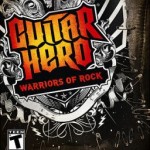 It was only recently that the relative merits and flaws of the two main contenders in the rhythm action genre became clear to me. During a frantic weekend of rhythm action-ing with a full band compliment, we managed to play almost every recent Guitar Hero and Rockband game. We experienced varying degrees of amusement with each, but the surprise for us was how well the newest Guitar Hero games performed. We all expected to spend most of our time playing the more “authentic” Rockband but after issues with unsupported DLC, microphones that weren’t recognised and general awkwardness, we found the immediacy and streamlined nature of Guitar Hero 5 and its willingness to let us play with three lead guitars to be a welcome surprise. How sad then that the hard working developers that implemented this feature (as well as many other clever ones) are all now looking for new jobs.
It was only recently that the relative merits and flaws of the two main contenders in the rhythm action genre became clear to me. During a frantic weekend of rhythm action-ing with a full band compliment, we managed to play almost every recent Guitar Hero and Rockband game. We experienced varying degrees of amusement with each, but the surprise for us was how well the newest Guitar Hero games performed. We all expected to spend most of our time playing the more “authentic” Rockband but after issues with unsupported DLC, microphones that weren’t recognised and general awkwardness, we found the immediacy and streamlined nature of Guitar Hero 5 and its willingness to let us play with three lead guitars to be a welcome surprise. How sad then that the hard working developers that implemented this feature (as well as many other clever ones) are all now looking for new jobs.
Activision’s culling of the Guitar Hero franchise was cruel and swift. While EA similarly sought to cut its losses with RockBand, there was a good deal less finality and callousness as they sought a buyer for the franchise. In comparison Guitar Hero was tossed aside rather more derisively and its hard to shake the image of a team of 500 developers thrown out into the gutter with a big pile of plastic guitars and broken drum kits.
So where did it all go wrong? Too many releases? That would certainly seem to be the general opinion online of both gamers and industry experts. Activision may fairly say that if they didn’t fill the gap in the market then someone else would. The truth though is that they more than likely cannibalised their own sales with multiple releases overlapping each other and in the end, they ate themselves. They could have been conservative with their release schedule and pushed out just one Guitar Hero a year. Consider the fact that anyone who tried to enter the rhythm action performed embarrassingly poorly and could never be competition or steal sales. We remember Rock Revolution don’t we? With one release a year, Guitar Hero games would show real improvements with each title.
The truth is the greed of the Publisher’s was uncontrollable as they made huge profits selling a whole new product (plastic instruments). They fell over themselves designing new and more complex but less useful peripherals. It takes a fucking amazing game to make someone buy a toy guitar for the first time, but when those games start to drop in quality those same guitars will very quickly find new homes in Cash Convertors.
We can trace the demise of the Guitar Hero franchise by going through the releases (oh so many of them) since 2005.
 1. Guitar Hero
1. Guitar Hero
In many ways a successor to previous music-based games like Frequency and Amplitude also made by Harmonix, this game was the real breakthrough. Harmonix leveraged a great gameplay idea with a perfect implementation and designed the note highway, score multiplier and star power mechanics all others would copy. They combined this with a slightly cheap but functional peripheral that let every rock fanboy channel their band fantasies and feel like a star, Most of the songs on the disk were (surprisingly good) cover versions as musicians from Prime Sound didn’t want to go near a game you played with a plastic guitar. The track list featured classics like “Iron Man”, “Bark at the Moon” and “Crossroads”. Guitar Hero changed everything.
 2. Guitar Hero 2
2. Guitar Hero 2
A more polished release than its predecessor, Guitar Hero 2 was the first title to be released on this generation of consoles as well as lasts, appearing on the Xbox 360 complete with the X-Plorer wired guitar peripheral. It added little mechanically to the gameplay formula but had greater support from the likes of Gibson guitars and Orange amps which featured prominently along with more original artist recordings of songs who had begun to take notice of the success of the franchise.
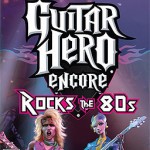 3. Guitar Hero Encore: Rocks the 80s
3. Guitar Hero Encore: Rocks the 80s
The last Guitar Hero game by Harmonix and a contractual obligation, this was a half-hearted release. Little innovation and a small tracklist sealed its fate. At this point the warning should have been clear that half-hearted or underwhelming releases would damage the future of the series, but with the developer changing the lessons seemed to have been lost.
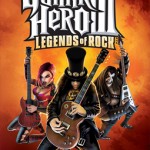 4. Guitar Hero 3: Warriors of Rock
4. Guitar Hero 3: Warriors of Rock
As Harmonix and Red Octane split, Guitar Hero was now owned by Activision and they put the Tony Hawks’ developer Nevrersoft to work on GH3. A great deal changed for Guitar Hero as Neversoft took the franchise in a new direction. Advertising was rife and was damaging to the tone of the game. The storyline told of the dangers of selling out while the arenas were sponsored by Axe deodorant. Meanwhile, the gameplay was modified extensively for special “boss battle” sections which featured power ups and guitar battles against famous guitarists like Slash and Tom Morello. Despite these less successfuly diversions, this was the most commercially successful of the Guitar Hero series. The art style was over the top but effective and the gameplay got its own distinctive feel. The note tracks were busy and the difficulty was high, but the timing windows were relaxed emphasizing quickness over precision. This allowed tracks like the epic “Through the Fire and Flames” to be ludicrously note heavy but still somewhat achievable with practice. The Les Paul controller featured detachable face plates and was the best made, most robust peripheral made to date.
 5. Guitar Hero Aerosmith
5. Guitar Hero Aerosmith
One of the first bands to realise the PR potential of having their names associated with a Guitar Hero game, Guitar Hero Aerosmith was a clever move for the crusty old rockers. No doubt due to the hunger of the public to get more songs to play the game sold well. Unfortunately this probably justified the increase in the number of Guitar Hero games Activision would put out in a year. It was also successful despite a lack of DLC and without many key Aerosmith songs that fans requested.
 6. Guitar Hero: World Tour
6. Guitar Hero: World Tour
The first game to openly compete with RockBand, Activision knew it had a big fight on its hands. EA had gotten Rockband to market first and Guitar Hero was in danger of losing out to its multi-instrument opponent. Worried that many gamers had already bought musical kits for one game and locked themselves in, Activision went balls out with the advertising and roped in every musician they could find to appear in promo videos for the game. They had always produced better guitar peripherals, so now they tried to produce a superior drum set too. The massive marketing push proved successful and while some elements of the gameplay (restoring beaten bandmates, solos) were still absent in Guitar Hero, they nonetheless proved successful through high production values and a few original community features like a music creation mode. Despite this a touchpad added to the new guitar added little innovation and the sales of peripherals began to wane as gamers retained their old instruments rather than buy new ones.
 7. Guitar Hero Metallica
7. Guitar Hero Metallica
A very similar entry to the previous Aerosmith entry, this saw lower sales despite the higher contemporary popularity of the crusty thrashers over the crusty old rockers. A good selection of bands that inspired the Metallica as well as high levels of collaboration with the core members of the band made the game a decent entry in the franchise, but the gravy train was starting to congeal by this point.
 8. Band Hero
8. Band Hero
This was a the pop-centric entry that questioned the sanity of the developers and publishers. Aimed at kids, it raised the question, “aren’t kids already playing guitar hero?”. The track list may have appealed to a pop centric audience, but surely they were all either playing SingStar, or downloading pop songs for the other versions of GH and RB.
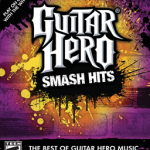 9. Guitar Hero Smash Hits
9. Guitar Hero Smash Hits
A horrible, penny chasing release aimed at hoovering up any fans willing to pay more money for songs they’ve already played in different formats. Developed cheaply and quickly, this was the death knell ringing louder than ever before and a sure sign Activision had no interest in the integrity of the series.
 10. Guitar Hero 5
10. Guitar Hero 5
Although a very strong game in its own right, this title did little to justify its number 5. Party play made it fantastically easy to jump in and out of games and was a great addition, but other than that you’d be lucky to find an important new feature. The touchpad was left out as a failed experiment and the music creator was beefed out, but you got the feeling at this point the whole series was freewheeling.
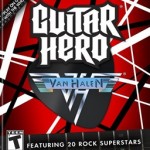 11. Guitar Hero: Van Halen
11. Guitar Hero: Van Halen
Originally planned to be a full release but reappraised due to the decline of the market, this was given away as a pre-release bonus with Guitar Hero 5 in some places and was available to download. A paltry 25 Van Halen songs and nothing from the later Hagar years angered many while many others were too apathetic to care.
 12. Guitar Hero Warriors of Rock
12. Guitar Hero Warriors of Rock
Once again Neversoft tried to go back to its original formula from Guitar Her 3 and wrap the career progression around a system of power ups and boss battles. The inclusion of famous musicians continues with Shirley Manson, Johnny Cash (somewhat distastefully) and others and the game retains the sensible party-play additions of GH5. The whole thing feels like a massive mis-step. With main competitor RockBand wooing the serious musicians, the storyline featuring demons and axes seemed childish and retrograde and the whole experience felt dated. The pointless axe shaped controller with detachable body added nothing to gameplay or design aesthetics and the track list contained an over-abundance of poor quality metal. You could feel the spectre of Guitar Her 3’s sales loom over the whole project, but everyone involved with the creation of the game failed to appreciate how much the market had changed since then. With a game containing all of the flaws of their first effort Neversoft had come full circle.
So there you go, 12 games (not counting mobile games) since 2005. Need we look further to find out why gamers are done with this series? We’re all human, we get bored when we’re not shown something new and we get pissed when we’re exploited or taken for granted. Activision must learn from this. If there’s a lists like this of Call of Duty games in 5 years then you can bet that franchise will die too. If that happens, what will take its place? New IP is the lifeblood of the industry, and right now Activision is a vampire quickly running out of victims.
